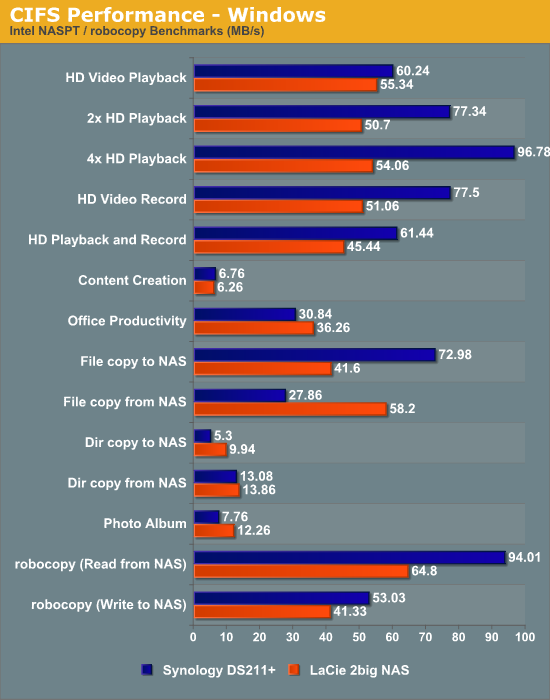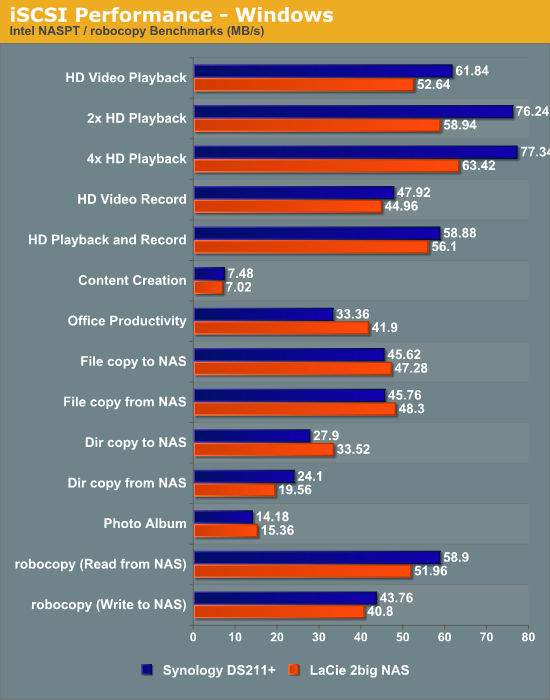LaCie's 2big NAS Review
by Ganesh T S on May 28, 2012 7:55 AM EST- Posted in
- IT Computing
- Storage
- NAS
- LaCie
The performance of the 2big NAS unit was evaluated on the Windows platform using Intel NASPT and our standard robocopy benchmark. As a comparative reference, we also ran the benchmarks using the same disks and under the same circumstances on the Synology DS211+.
The first set of graphs below shows the performance of Samba shares on the LaCie 2big NAS as compared to the Synology DS211+ (updated to the latest DSM 4.0-2228).

We also created a 100 GB iSCSI target and mapped it on the Windows VM. The same benchmarks were run and the results are presented below.

We find that the performance is affected by two factors, namely, the amount of memory in the NAS and the host processor's speed. While the DS211+ scores better in the former category, the LaCie 2big NAS has a 400 MHz advantage in the latter. That said, the DS211+ scores better in more benchmarks (and importantly, in the robocopy benchmark) than the LaCie 2big NAS. This implies that there is lot of scope for improvement in performance in LaCie's NAS OS 2 (and not all of the shortcomings might be due to the lesser amount of DRAM). That said, the 2big NAS is priced lower than the DS211+, so a difference in performance might well be expected.










15 Comments
View All Comments
DukeRobillard22 - Tuesday, May 29, 2012 - link
The question I always have about a NAS, and which is hard to find out, is "what filesystem does it use?" Like, when its power supply dies, can I pull one of the mirrored disks out, plug it into a SATA port on my Linux box, and get at the data? While it's true the the disks themselves are probably the mostly likely thing to fail, they're not the only thing.Currently, I use an old PC running Fedora with software RAID, just so I can do that when some piece of hardware lets out the magic smoke.
KLC - Tuesday, May 29, 2012 - link
Every time I read an NAS review I'm struck by how expensive they are. More than 2 years ago I bought an Acer Windows Home Server box. It has 4 hot swappable drive bays, an atom processor with 1 gb of memory and Windows Home Server V1. With one 1tb drive it cost me $350 on sale, regular price was $399. Two years later and I see systems with less capability than that one yet they are much more expensive. Why do NAS systems defy Moore's law of more computing capability for less money over time?EddieBoy - Wednesday, May 30, 2012 - link
I keep thinking that I need something to replace my aging Windows Home Server setup. This looks like it might do the trick.But now I am concerned about the Seagate acquisition and whether that might affect their quality and customer support.
Any thoughts on how the acquisition might affect this company?
Thanks.
Zak - Sunday, June 3, 2012 - link
Do these overheat and fry their electronics like most of LaCie enclosures?klassobanieras - Tuesday, June 12, 2012 - link
As the owner of a 4-disk ReadyNAS NV I always felt quite smug about my data until the box itself went bad. This taught me to ask certain awkward questions:- What if the box fails? Do I need to buy another identical box to get my data off my disks or will (e.g.) a Linux machine understand them ok?
- Is it susceptible to the RAID write-hole? Do I need a UPS?
- What kind of data-integrity does it provide, relative to the state-of-the-art (ZFS, btrfs et al)?
Respectfully, I'd suggest that if you're going to seriously test NASes you need to (a) repeatedly yank the power-cord in the middle of metadata-heavy writes, (b) try getting your data off the disks without the use of the NAS itself, (c) see how it deals with a flaky drive and (d) test for data integrity, not just filesystem integrity.
Finally, NASes should be judged in the context of what you can get from an el-cheapo PC running FreeNAS with ZFS, which IMHO puts most consumer NAS boxes to shame.